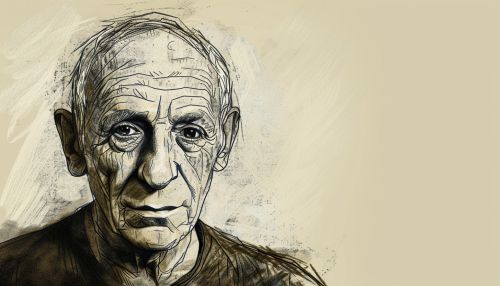Pablo Picasso
Early Life
Pablo Diego José Francisco de Paula Juan Nepomuceno María de los Remedios Cipriano de la Santísima Trinidad Ruiz y Picasso, known as Pablo Picasso, was born on October 25, 1881, in Málaga, Spain. He was the first child of Don José Ruiz y Blasco, a school teacher and a painter, and María Picasso y López. Picasso's interest in art was nurtured from a young age by his father, who was a traditional, academic artist and instructor at the School of Fine Arts in Málaga.
Artistic Training
Picasso received formal artistic training from his father in figure drawing and oil painting from 1890. At the age of 14, Picasso completed the one-month qualifying examination of the Academy of Fine Arts in Barcelona, where his family had moved in 1895, in just one day. His early works, such as the "First Communion" (1896), were influenced by his father's academic style.
Blue and Rose Periods
Picasso's work is often categorized into periods. The first of these, the 'Blue Period', began after his friend Carlos Casagemas committed suicide in 1901. During this time, Picasso painted essentially monochromatic paintings in shades of blue and blue-green, with occasional warm accents. Works like "The Old Guitarist" (1903) are characteristic of this period.
In 1904, Picasso's palette began to brighten, and he started using pinks and other light colors, which led to his 'Rose Period'. This period is characterized by a more cheery style with orange and pink colors, and featuring many circus people, acrobats and harlequins known in France as saltimbanques. A good example is the "Family of Saltimbanques" (1905).
African Art and Primitivism
From 1907 to 1909, Picasso entered a new phase, labeled the 'African Art' or 'Primitivism' period. This was significantly influenced by African sculptures and traditional African masks. Picasso's painting "Les Demoiselles d'Avignon" (1907), is considered a seminal work of this period, and is seen as a proto-Cubist work.
Cubism
Picasso, along with Georges Braque, developed Cubism around 1909-1912. This revolutionary new style reduced everything – figures, objects and landscapes – to geometric outlines and forms like cubes, spheres, cylinders and cones. Picasso's "The Young Ladies of Avignon" and "Guernica" are prime examples of Cubist principles.
Later Works
In the later years of his life, Picasso turned to creations of fantasy and comic invention. He continued to work in sculpture, ceramics, and other media, and explored different artistic styles, always reinventing his artistic style. Picasso's final works were a mixture of styles, his means of expression in constant flux until the end of his life.
Legacy
Picasso is regarded as one of the most influential artists of the 20th century. He is known for co-founding the Cubist movement, the invention of constructed sculpture, the co-invention of collage, and for the wide variety of styles that he helped develop and explore.
See Also


